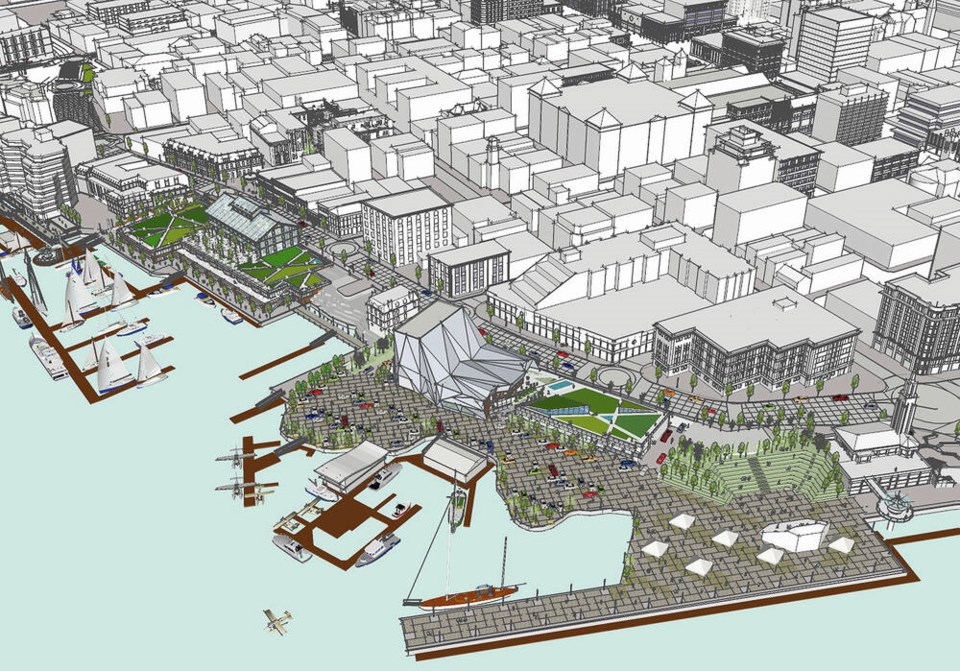A commentary by a local architect and urban design planner who has worked for more than 30 years in downtown Victoria.
Times of change and challenge are clearly underway for Victoria — what to do, where to look?
As for others, a recent anniversary visit to Italy revealed a society that seems to live well — prudently, wisely — even in their own demanding circumstances. Throughout our month of travels, town after town featured Italians, with multitudes of visitors, thronging to enjoy beautiful historic, but modernized cities.
Some homelessness no doubt, but hard to see, and little public misbehaviour — mostly good-spirited crowds, active daily throughout city centres of all sizes — districts full of independent shops, restaurants, fashions, street music and excellent public art, ancient and modern.
In even modest towns, central streets most evenings fill with La Passeggiata as friends and families promenade, and dine in downtown plazas suddenly filled with outdoor seating.
The festivities continue to late evening, with all ages from one to 100, dressed up and buzzing.
Well-cared-for heritage buildings and districts are a given, with strict protections.
Earthquake risks have triggered extensive national seismic upgrades programs. Diminutive and monumental public buildings everywhere, including both exquisite small and majestic churches, are safeguarded and multi-purposed for diverse cultural activities.
Modernist Italy is also in full abundance, with superb new high-speed railway services and stations, elegant city landscaping, excellent new architecture, and reliably beautifully appointed pedestrian areas. New high-rises are modest in scale, often with ingenious designs and are usually discretely set as backdrops to historic character areas.
Public squares typically feature central fountains, many ancient, some contemporary, which are valued in perpetuity as signature public properties. Proposals for careless removal or destruction of architectural and cultural landmarks are virtually unheard of.
Vandalism in these parts was all too familiar 1,500 years ago, and is now just not indulged. Contemporary Italy is not free of its share of fiscal, birthrate, employment, and climate change challenges, but a society that so well blends cultural guardianship with adventurous style presents its own very evident sustainability.
So, what lessons for our own uncertain town? What dynamic balance of caution and creativity, of discretion and ambition, might help Victoria weather and flourish in our unsettled era?
A few samples of suggested wisdoms, some moderate, some ambitious:
New housing is a pressing mandate, so upgrade lovely neighbourhoods by favouring building conversions and additions, rather than out-of-context packing-box structures.
Our recent multi-unit heritage-adaptive rezoning at 1442 Elford St. won a heritage award, and no community complaints.
Climate change seems poised to bedevil this century, but eventually we will face its even more ominous concealed cousin: the threat of a large seismic disaster.
This should be prepared for with respect rather than fear: an example of precaution for upgrading neighbourhoods is by lifting homes onto sound new footings, with enhanced wood framing, all for more housing units.
Seismic challenges to Victoria’s major heritage buildings should also prompt progressive long-term initiatives, rather than paralyzed angst. Some aspiring examples:
• Update the opportunely located Bay Street Armouries with improved seismic capacities, as a community emergency-services complex, also for health care and transitional housing uses.
• Add a missing south wing to the Empress Hotel, with new conference and exhibition facilities on a below-grade floor, providing an economic boost to support seismic updating for a venerable steel-framed landmark.
• Similarly, dig down around the Parliament Buildings to insert seismic base isolation treatments and then to help justify this very costly upgrade, create valuable new public areas adjacent in below-grade additions. Look to parallel recent examples at the Quebec legislative building, and in Ottawa’s Parliament Hill buildings.
• For Victoria’s invaluable Old Town, continue conserving a district that compares well with older European cities, through seismic upgrades and in-scale upper floor housing additions.
• For Victoria’s many imposing downtown churches: occupancy, seismic, and economic challenges call for innovative, committed long-term programs. Over time these irreplaceable buildings may prove ideal for enhanced community and cultural uses, supported by adjacent new housing.
• For the under-used Ship Point site, resist impulses to subject this to narrow-purpose, low-use landscaped park treatments. Instead, feature a combination of a multi-use festival plaza, multi-transportation uses, and accentuated cultural urban design.
Architect Terry Williams’ recent advocation for a new civic multi-use theatre or opera house here could provide for a wonderful animating feature. I worked with Terry on the design of the Nanaimo Port Theatre. There could be a similar 900 to 1,000 seat facility on Ship Point, set behind a multi-use festival waterfront plaza, still allowing space for an adjacent civic museum or art gallery, with a roof-top public terrace as well as a landscaped amphitheatre facing the Inner Harbour.
Challenges of change and of large long-term urban ambitions are of course daunting and thus all the more reason to consider the time-tested wisdom of our civilized European cousins: look to the future creatively but judiciously.
Take care to offset reaching forwards, with respectful maintenance of the illustrious best assets of the past.
And be sure: No self-respecting Italian community would contemplate disposing of Victoria’s lovely, classic mid-century Centennial Square Fountain.
>>> To comment on this article, write a letter to the editor: [email protected]



